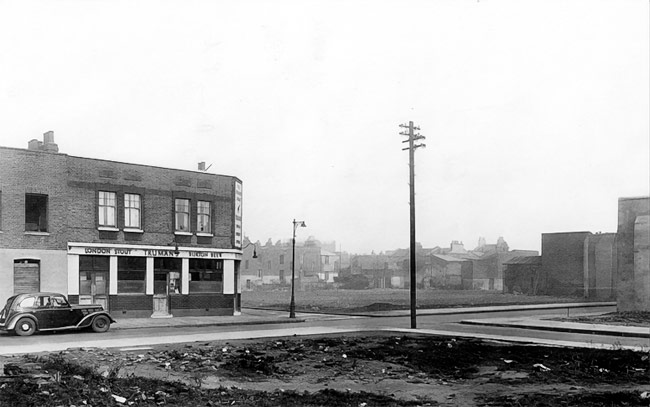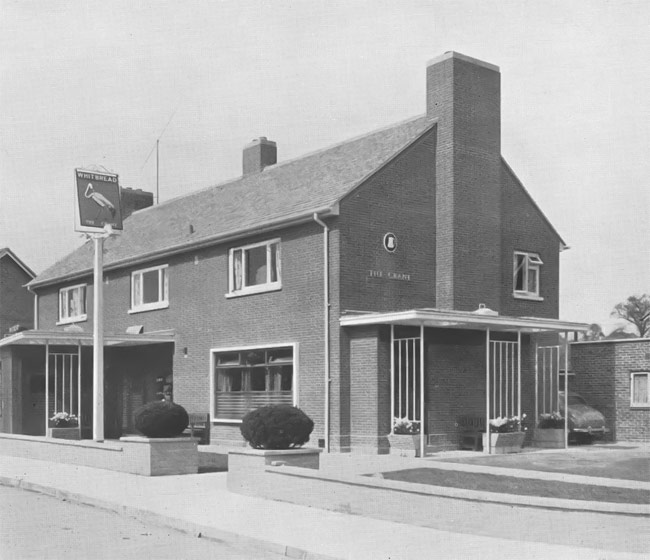Visit the Boak and Bailey's Beer Blog site
The first significant post-war pub was more than a pub – it was a prototype, an exhibit and, perhaps surprisingly, built to last.
We first noticed The Festival Inn on the corner of Chrisp Street Market in Poplar, East London, more than a decade ago. On one of our long walks through the infinitely fascinating neighbourhoods between Walthamstow, where we lived, and the City of London, we spotted its fading 1970s Truman’s livery and paused to take some pictures.
Only years later, having developed an interest in architecture and town planning, and gearing up to write 20th Century Pub, did we realise its true significance.
In the late 1940s, Britain was still recovering from the Blitz. Rationing was still in place for many consumer items and the supply of building materials was severely restricted. The supply of men to use them was short, too, with many still serving in the armed forces. The only new pubs being opened were prefabs – and even those were sometimes controversial.
Then along came the Festival of Britain. Scheduled for 1951, it was designed to offer a vision of a post-austerity Britain, to lift the national mood and to put a definitive full stop on World War II.
For the Festival, all kinds of exceptions were made to the rules and regulations around construction and the organisers were given dibs on material and manpower. As well as the main Festival site on the South Bank of the Thames – the one you’ll generally see in old newsreel footage – there were other exhibitions across London and around the UK.
Among the most ambitious, and most practical, was the ‘Live Exhibition of Architecture’ at Poplar which saw the construction of the largest part of an entire new housing estate, from scratch. In fact, the LCC had been planning to build a new estate there anyway, to be known as Lansbury; the Festival just sped things up and ensured the involvement of Top Men.
The architectural exhibition was conceived by architect Frederick Gibberd, who also designed the shopping centre at Chrisp Street around which the estate centred.
Newsreel footage of the King and Queen visiting the building site at Lansbury. Gibberd played an important role in designing post-war Britain, from the distinctive BISF council house – a pragmatic response to the housing shortage – to the utopian vision of Harlow new town.
Gibberd’s design for Chrisp Street included two pubs, one at either corner of the shopping centre. Only one would be open in time to form part of the architectural exhibition, however – the appropriately named Festival Inn.
 Detail from a plan of the exhibition from the official programme. The Festival Inn is marked 15, at the centre, with the other 15, on the right edge, being The Festive Briton, AKA Callaghan’s. If Lansbury was a dry run for Harlow, Crawley and Stevenage, The Festival Inn was the prototype for their pubs. It was to be owned and operated by East End brewers Truman’s and took on the licence of The Grundy Arms, a Victorian pub that survived the Blitz but was demolished as part of the clearance of the Chrisp Street area.
Detail from a plan of the exhibition from the official programme. The Festival Inn is marked 15, at the centre, with the other 15, on the right edge, being The Festive Briton, AKA Callaghan’s. If Lansbury was a dry run for Harlow, Crawley and Stevenage, The Festival Inn was the prototype for their pubs. It was to be owned and operated by East End brewers Truman’s and took on the licence of The Grundy Arms, a Victorian pub that survived the Blitz but was demolished as part of the clearance of the Chrisp Street area.
 The Grundy Arms. SOURCE: London Metropolitan Archive/PubWiki. The exterior of The Festival Inn was designed by Gibberd because it was integrated into a block that housed a shopping arcade. The interior was the work of Truman’s own in-house designer R.W. Stoddart. It took the form of a traditional pub with multiple bars but with the clean, straight-edged, minimal look typical of post-war buildings.
The Grundy Arms. SOURCE: London Metropolitan Archive/PubWiki. The exterior of The Festival Inn was designed by Gibberd because it was integrated into a block that housed a shopping arcade. The interior was the work of Truman’s own in-house designer R.W. Stoddart. It took the form of a traditional pub with multiple bars but with the clean, straight-edged, minimal look typical of post-war buildings.
 Kerbey Street elevation of the Festival Inn by Frederick Gibberd. SOURCE: Brewing Trade Review, January 1951.
Kerbey Street elevation of the Festival Inn by Frederick Gibberd. SOURCE: Brewing Trade Review, January 1951.  Artist’s impression of the Festival Inn – also by Gibberd? SOURCE: Brewing Trade Review, January 1951. The interior of the pub, as described in The Brewing Trade Review for January 1951:
Artist’s impression of the Festival Inn – also by Gibberd? SOURCE: Brewing Trade Review, January 1951. The interior of the pub, as described in The Brewing Trade Review for January 1951:
The house has a large public bar with recess for dart playing. The walls will be panelled to dado height with oak panelling. The fireplace will be of brick and stone with a large mural above it depicting a scene from the nearby docks. At the rear end of the bar a small glass dome is formed to give additional light to the bar. The service counter will have an oak-panelled front with a plastic top. Above the counter there will be cold cathode lighting to give a warm honey-coloured light… There are two saloon bars linked by an opening next to the fireplaces.
There was also a mirror featuring Abram Games’ famous Festival of Britain logo.
The pub sign, situated a little way from the entrance, was to depict children dancing round the famous space age Skylon as if it were a maypole – a fantastic representation of the collision of national tradition and futurism represented by the Festival as a whole.
 SOURCE: The Sphere, 2 June 1951, via The British Newspaper Archive. That theme continued in the publicity surrounding the pub’s construction and when its first chimney was completed in December 1950, a ceremony was held. Beer was delivered by horse-drawn dray and ‘ale wives’ in traditional costume hoisted a garland and served beer to the chimney by way of a blessing. Covering this event, The Sphere for 30 December 1950 described The Festival Inn as ‘an example of modern planning on traditional lines’.
SOURCE: The Sphere, 2 June 1951, via The British Newspaper Archive. That theme continued in the publicity surrounding the pub’s construction and when its first chimney was completed in December 1950, a ceremony was held. Beer was delivered by horse-drawn dray and ‘ale wives’ in traditional costume hoisted a garland and served beer to the chimney by way of a blessing. Covering this event, The Sphere for 30 December 1950 described The Festival Inn as ‘an example of modern planning on traditional lines’.
In 1951, The Festival really was a sign of hope. Pubs destroyed in the Blitz would be replaced; communities would be rebuilt. It was open and trading as a pub from 2 May that year, serving both Festival visitors and market traders.
The similarly named Festive Briton, on the opposite side of the market square, didn’t open until 1952 and, anyway, lacked the razzle-dazzle that made The Festival a headline grabber.
Just as Lansbury would inspire the look and layout of new towns around the UK, The Festival Inn would produce its own offspring.
 The Crane, Basildon. SOURCE: A Monthly Bulletin, June 1954. Over the years, Lansbury weathered down and got worn in, and The Festival became part of the furniture. The sign disappeared at some point and the delicate new-Elizabethan lettering on the outer wall was replaced with Truman’s livery that was somehow both more up-to-date and more old-fashioned.
The Crane, Basildon. SOURCE: A Monthly Bulletin, June 1954. Over the years, Lansbury weathered down and got worn in, and The Festival became part of the furniture. The sign disappeared at some point and the delicate new-Elizabethan lettering on the outer wall was replaced with Truman’s livery that was somehow both more up-to-date and more old-fashioned.
 The Festival Inn c.2008. Amazingly, 70 years on, The Festival Inn is still there and still trading, albeit on pause for COVID-19. It’s also remarkably well preserved inside and features in CAMRA’s official listing of historic pub interiors. It’s also now Grade II listed by Historic England, too, so is protected, at least structurally, whatever else might happen to the Chrisp Street Market area in years to come.
The Festival Inn c.2008. Amazingly, 70 years on, The Festival Inn is still there and still trading, albeit on pause for COVID-19. It’s also remarkably well preserved inside and features in CAMRA’s official listing of historic pub interiors. It’s also now Grade II listed by Historic England, too, so is protected, at least structurally, whatever else might happen to the Chrisp Street Market area in years to come.
Could Britain’s first modern post-war estate pub also end up being its last? It’s entirely possible.
Notable pubs: The Festival Inn, Poplar, 1951 originally posted at Boak & Bailey's Beer Blog
More...
Detail from a plan of the exhibition from the official programme. The Festival Inn is marked 15, at the centre, with the other 15, on the right edge, being The Festive Briton, AKA Callaghan’s. If Lansbury was a dry run for Harlow, Crawley and Stevenage, The Festival Inn was the prototype for their pubs. It was to be owned and operated by East End brewers Truman’s and took on the licence of The Grundy Arms, a Victorian pub that survived the Blitz but was demolished as part of the clearance of the Chrisp Street area.
The Grundy Arms. SOURCE: London Metropolitan Archive/PubWiki. The exterior of The Festival Inn was designed by Gibberd because it was integrated into a block that housed a shopping arcade. The interior was the work of Truman’s own in-house designer R.W. Stoddart. It took the form of a traditional pub with multiple bars but with the clean, straight-edged, minimal look typical of post-war buildings.
Kerbey Street elevation of the Festival Inn by Frederick Gibberd. SOURCE: Brewing Trade Review, January 1951.
Artist’s impression of the Festival Inn – also by Gibberd? SOURCE: Brewing Trade Review, January 1951. The interior of the pub, as described in The Brewing Trade Review for January 1951:
SOURCE: The Sphere, 2 June 1951, via The British Newspaper Archive. That theme continued in the publicity surrounding the pub’s construction and when its first chimney was completed in December 1950, a ceremony was held. Beer was delivered by horse-drawn dray and ‘ale wives’ in traditional costume hoisted a garland and served beer to the chimney by way of a blessing. Covering this event, The Sphere for 30 December 1950 described The Festival Inn as ‘an example of modern planning on traditional lines’.
The Crane, Basildon. SOURCE: A Monthly Bulletin, June 1954. Over the years, Lansbury weathered down and got worn in, and The Festival became part of the furniture. The sign disappeared at some point and the delicate new-Elizabethan lettering on the outer wall was replaced with Truman’s livery that was somehow both more up-to-date and more old-fashioned.
The Festival Inn c.2008. Amazingly, 70 years on, The Festival Inn is still there and still trading, albeit on pause for COVID-19. It’s also remarkably well preserved inside and features in CAMRA’s official listing of historic pub interiors. It’s also now Grade II listed by Historic England, too, so is protected, at least structurally, whatever else might happen to the Chrisp Street Market area in years to come.




 Reply With Quote
Reply With Quote